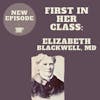First in Her Class: Elizabeth Blackwell, MD

The first to earn a medical degree in the United States, Elizabeth Blackwell broke barriers and carved a path for others to follow. Graduating at the top of her class, Blackwell would fight to create a medical practice and would spend her life championing medical education for other women.
So just who was Elizabeth Blackwell? Tune in to find out.
SOURCES
Blackwell, Elizabeth. Pioneer work in opening the medical profession to women. United Kingdom: Longmans, Green and Company, 1895.
Blackwell, Emily., Blackwell, Elizabeth. Address on the Medical Education of Women. United States: Baptist & Taylor, book and job printers, Sun Building, corner of Fulton and Nassau Sts., 1864.
Clausen, Carol. “Elizabeth Blackwell: “That Girl There is a Doctor In Medicine” Part I - Circulating Now from the NLM Historical Collections.” March 11, 2021. (LINK)
Clausen, Carol. “Elizabeth Blackwell: “That Girl There is a Doctor In Medicine” Part II - Circulating Now from the NLM Historical Collections.” March 25, 2021. (LINK)
Mensik, Hailey. “Women making up more of physician workforce.” January 13, 2023. Healthcare Dive. (LINK)
Michals, Debra. "Elizabeth Blackwell." National Women's History Museum. 2015. (LINK)
“National Health Society.” Social Networks and Archival Context. (LINK)
Rosenberg, Charles E. “Social Class and Medical Care in Nineteenth-Century America: The Rise and Fall of the Dispensary.” The Journal of the History of Medicine and Allied Sciences, vol. XXIX, issue 1, January 1974. Pages 32–54, https://doi.org/10.1093/jhmas/XXIX.1.32
Welcome to Civics and Coffee. My name is Alycia and I am a self-professed history nerd. Each week, I am going to chat about a topic on U.S history and give you both the highlights and occasionally break down some of the complexities in history; and share stories you may not remember learning in high school. All in the time it takes to enjoy a cup of coffee.
INTRO MUSIC
Hey everyone, welcome back.
As of 2021, roughly 37% of medical doctors in the United States were women. Despite being roughly half the population, the medical profession is still dominated by men. Though figures are getting better with each year, I thought I would look at the first to break the gender mold.
Elizabeth Blackwell became the first woman in America to receive a medical degree when she graduated at the top of her class in 1849. Facing massive resistance and challenging gender stereotypes, Blackwell carved a path for both herself and future generations of women.
So, this week I am diving into the history of Elizabeth Blackwell. Who was she? What made her pursue medicine? And what legacy did the leave behind?
Grab your cup of coffee, peeps. Let’s do this.
Born in Bristol, England on February 2nd, 1821, Elizabeth Blackwell was one of nine children. Her father, Samuel, was a quaker and antagonistic of slavery, earning his living as a sugar refiner. The large family lived together on a compound of sorts, with two houses and a courtyard within close proximity to her father’s office and sugar refinery. Writing about her memories of her birthplace later in life, Blackwell described the area as quote “delightfully free and open,” end quote. As a young girl, she and her siblings would walk about the estate and into the surrounding areas such as Leigh Woods.
In 1832, the Blackwell’s made the decision to emigrate to the United States. It is unclear the exact motivations prompting the move, however part of the decision could have been influenced by the cholera epidemic sweeping through the UK at the time. Whatever the motivations, in August of 1832, Elizabeth, her siblings, and her parents boarded a ship and made sail for New York.
While in New York, the Blackwells met abolitionist and newspaper publisher William Lloyd Garrison and Elizabeth attended school. A few years after their arrival in the states, the family picked up stakes once again, moving to Cincinnati Ohio in 1838. In her memoir Blackwell describes the motivation to move came from a potential business opportunity, however tragedy would soon strike her family as her father passed away from a quote “bilious fever” end quote just months after their arrival.
Losing her father meant the loss of the primary breadwinner for the family and the Blackwell women entered the workforce in the most common and socially acceptable jobs for women: teacher. Though it paid the bills and helped her family, Elizabeth found little joy in the work. Ever the dutiful daughter, Blackwell continued teaching until a sick friend made a comment that inspired her to aim higher. Her friend, a woman who was terminally ill, mentioned to Elizabeth how she felt her experience navigating her illness would have been better had her physician been a woman. Further, this friend told Blackwell she felt she had what it took to be successful in medicine.
The idea of women practicing medicine in any formal way was a bit of a wild concept. While women had acted as midwives and nurses for centuries, they had been shut out from participating in the increasingly professionalized medical field. Medical schools in the United States had been around since the 18th century, however in order to gain entry to the school, applicants had to have prior medical training, such as apprenticing with established physicians and had to have a decent command of the greek language. Given these requirements, and the expectations of women during the period, many women were unprepared to attend medical colleges.
Blackwell faced several hurdles in her desire to become a physician. First, of course, she was a woman. Second, she did not have the money needed to attend school. Third, she lacked the requisite apprentice experience with established practitioners. And finally, her education at a female focused academy meant her science and classical language skills were deficient. Nevertheless, Blackwell was determined to get into a medical school. She found a teaching assignment that allowed her to board with established physicians where she could study their medical textbooks and practice her Greek.
Despite her preparations, several individuals felt that as a woman, Blackwell’s desire to attend medical school were dead in the water. Friends and associates even suggested that Elizabeth disguise herself as a man if she truly wanted to become a physician as no quality medical school would admit a woman. Stubborn and unwilling to resort to tricks to get in, Blackwell sent off her applications. As expected, all of the well known institutions soundly rejected her request. However, in a strange twist of fate, a small medical school in western New York sent word she had been accepted.
Geneva Medical School, established in 1835, received Blackwell’s application and were against her admittance, however they felt they had no justifiable reason to reject her. For some unknown reason, the school decided to let the student body choose. They put her application forward and the students, believing the request to be a practical joke, voted unanimously to admit Blackwell.
In order to successfully graduate, students attending Geneva Medical school had to attend two sixteen-week series of lectures, write a thesis, and take an oral exam. Blackwell wasn’t admitted until several weeks into the first term, meaning she was already starting from behind. Despite her admittance, Blackwell wasn’t entirely welcomed at her new school. Several professors insisted she sit separately from her male classmates and at least one member of the college raised concerns about Blackwell attending an anatomy class as the experience was considered inappropriate for a lady.
For her part, Blackwell did her best to ignore the stares and charges of insanity. Instead, she focused on displaying her intellectual capabilities, working hard to be seen as a perfect student. Her plan worked and Blackwell successfully completed her training, writing a thesis on typhus, and graduating at the top of her class in 1849. News of her accomplishment made international headlines and while most reports were neutral, at least one article called the entire experience a farce and shared their feeling that Blackwell should be an exception and not the rule.
Hoping to further her training, Blackwell went overseas to study in Paris and London. Upon her arrival, she was met with much the same discrimination and prejudice as she has in the states, with the medical facility in Paris relegating her to primarily midwifery duties. While in Europe, Blackwell studied women and children’s diseases, hoping to leverage her training into a successful practice upon her return to the United States. However, once back in New York, Blackwell continued to be stymied in her efforts to practice medicine. She sought admittance to the city’s dispensary, which was the nineteenth century equivalent of a clinic, only to find her request denied. Several individuals suggested she open her own as it was unlikely she’d be allowed into the city system.
Unable to establish a practice, Blackwell focused on promoting preventative treatments and hygiene. She wrote a series of lectures on women’s physical education which she later referred to as her quote “first start in practical medical life,” end quote. In December of 1855, Blackwell also gave a speech about the need to open up the field of medicine to more women. Included in her remarks was her personal experience in combatting the notion that women were simply not meant to pursue a medical education and a call to allow women to study medicine across the country. Blackwell laid out a plan for how medical schools established for women would function, highlighting the need for several structural changes given that women were often poorer than their male counterparts and received less rigorous training in school.
Though she enjoyed her work in prevention and promoting women in the field, Blackwell wanted to practice medicine. Still shut out from New York’s dispensary, Blackwell decided to move forward with opening her own, writing quote: “being still excluded from medical companionship, and from the means of increasing medical knowledge which dispensary practice affords, I finally determined to try and form an independent dispensary,” end quote.
Blackwell started small, hosting patients just three afternoons a week. Her services were limited and she focused her treatment on women and children. In her memoir, Blackwell described the dispensary as a quote unquote Quaker practice as they were her most frequent patients. But despite the services she provided, Blackwell still noticed a disparity for female medical practitioners. In her telling, quote: “although college instruction was being given to women students in some places, no hospital was anywhere available either for practical instruction or the exercise of the woman-physician’s skill. To supply the need had become a matter of urgent importance,” end quote.
Thus, Blackwell moved forward with opening the New York Infirmary for Indigent Women and Children. Establishing the facility with her sister Emily, who had trained as a surgeon, and another female physician, Blackwell opened up the infirmary May of 1857. Completely run and managed by women, the infirmary was more akin to a true medical practice with hospital beds and places for surgical patients. To give the institution an aura of legitimacy, Blackwell successfully convinced several male doctors to join a consulting board. Despite these efforts, the hospital still faced its fair share of criticism. Detractors claimed a hospital run by women would be unsuccessful as their work, such as issuing death certificates, would not be recognized and they would be unable to control their patients. Blackwell and her fellow female physicians got the last laugh. The infirmary was successful and still exists today as the New York University Downtown Hospital.
When the Civil War ripped the country apart, Blackwell focused her attention on training union nurses. Working in collaboration with fellow members of the Ladies’ Sanitary Aid Association, Blackwell helped coordinate a training program for nurses, only the best of which would be sent on to aid soldiers along the front.
After the war, Blackwell turned her attention again to the medical education of women in New York. Given her own experience, Blackwell felt that women should not be relegated to separate medical schools and that there were benefits for both men and women to have a coed education experience. With this in mind, Blackwell attempted to convince local medical schools to accept women into their program if they were certified by her infirmary. However, her request went unanswered. Undeterred, Blackwell moved forward with establishing a medical college for women, opening the institution in 1868 where she served as the chair of hygiene. As the school was established through a charter from the infirmary, her sister also took on an educational position, acting as a professor of obstetrics and disease for women. Blackwell left the school in 1869 to take up residence in the country of her birth, leaving her sister Emily in charge.
Dr. Blackwell remained in England for the rest of her life. She continued her medical career, setting up a practice in London. In 1871, she helped establish the National Health Society which aimed to increase public health by sharing information. In line with Blackwell’s earliest work in hygiene, the society helped by sharing cutting edge research and information on the prevention of disease. Still committed to increasing the status of women within the field, the National Health Society also worked to promote
more formal training for females.
Retiring from medicine in 1880, Blackwell spent her remaining years championing causes she believed in and working on her memoir, which was published in 1895. She suffered a fall in 1907 which left her permanently disabled and passed away three years later at the age of 89.
Fearless, tenacious, and unwilling to compromise her beliefs, Dr. Elizabeth Blackwell challenged gender norms to become the first female physician in the United States. And though she was the first, Blackwell took concrete steps to ensure she would not be the last, spending her life creating opportunities for other women to follow in her footsteps. Her lifelong efforts contributed to hundreds of women obtaining medical training and opened countless doors.
Her influence hasn’t gone unnoticed. On the 100th anniversary of Blackwell’s medical degree conferral, the American Medical Association set up an award in her honor. Called the Elizabeth Blackwell Medal, the award is presented annually to female physicians who make quote “outstanding contributions to the cause of women in the field of medicine,” end quote.
Not a bad legacy for a woman from Bristol.
Be sure to come back next week as I share the story of yet another medical pioneer.
Thanks, peeps. I’ll see you next week.
Thanks for tuning and I hope you enjoyed this episode of Civics & Coffee. If you want to hear more small snippets from american history, be sure to subscribe wherever you get your podcasts. Thanks for listening and I look forward to our next cup of coffee together.
OUTRO MUSIC
Listener Favorites
Not sure where to begin? Take a listen to some fan favorites.

























